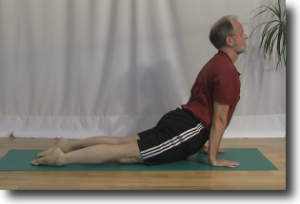Look at a suspension bridge.
There are two high towers and two low towers. The suspension cables go from the low tower up to the high tower and then the cables hang down between the two high towers.
Upward Facing Dog looks a lot like a suspension bridge.
- The arms are the high tower
- The feet are the low tower
- The torso and legs are the cable
Following the Suspension Bridge Method you can remove the pain from your lower back when you do Upward Facing Dog.
What is Upward Facing Dog
Upward facing dog (Sanskrit – Urdhva Mukha Svanasana) is one of the nine poses of the Sun Salute series. A Sun Salute consists of a series of poses that are done to the breath. You inhale and do one of the poses and then you exhale and move on to the next pose. Upward facing dog is one of the poses in the middle of the Sun Salute series.
How to do upward facing dog
You enter Upward Facing Dog from Chaturanga Dandasana.
In Chaturanga Dandasana you are hovering in low plank with your body off of the floor and just your hands and feet on the floor. If you are lacking in upper body strength your body will be resting on the floor instead of hovering just off of the floor.
From Chaturanga Dandasana you start inhaling and lift your shoulders and torso up and straighten your arms. You move your hips forward toward your arms as you lift your shoulder up toward the ceiling. You roll over your toes and bring the top of your feet toward the floor as you continue to straighten your arms.
Your shoulders are above your hands.
You gaze toward the horizon.
Even though this posture is easy to move into, if you do not do it carefully you can injure your lower back.
How to injure your lower back
There are two ways to inury your lower back.
- let your body sag down between your shoulders
- Force your hips forward and downward toward the floor.
As a result of these two actions you can injure your lower back in this pose.
Why the injury happens
There are several reasons why you hurt your lower back in Upward Facing Dog.
Your hips are tight
Your hips are not as flexible as they need to be. This means that the hips will tend to higher from the floor because back and the legs cannot bend backwards enough to support the bend that the teacher is showing you when they demonstrate the pose.
Your shoulders are weak
If you are lacking in upper body strength you will tend to let the body sag down between the shoulders. Your shoulders will rise up toward your ears and your hips will sag down toward the floor. When the hips sag toward the floor you are increasing the curve in the back at the hips. This increased curve will cause compression and pain in your lower back.
Your feet are in the wrong place
If your feet are too closer to your hands you will increase the curve in your lower back and some discomfort and pain.
There are several things that you can do protect your lower back with the Suspension Bridge Method.
How to protect your lower back in Upward Facing Dog
Following the Suspension Bridge Method you let your body suspend naturally between your shoulder and feet. You do not force your hips down toward the floor. Nor do you force your hips forward between your arms. You let your body hang naturally between your shoulders and your feet.
Let’s look in detail at how we set up these two suspension points and the cable of the Suspension Bridge Method.
Establish the high tower
Your shoulders are the high suspension point. You lift your torso up between your shoulders. You bring your shoulder blades back and down your back. This movement will establish the high suspension point and give you a firm foundation.
Anchor the low tower
Your feet are the low suspension point. The tops of your feet are flat to the floor with the toes pointing away from your hands. Your feet are hip width apart which is about 6 – 8 inches of space between them.
Setup the cable
Your back and legs are the cable of the Suspension Bridge. You bring your ribs forward between your arms. You let you hips suspend naturally. You do not try to move your hips down toward the floor. Tuck your tail bone in slightly in to the body. And finally your knees should be slightly off of the floor.
Adjust the cable
If there is some discomfort in your lower back you may need to move your feet closer to your hands or further away from your hands to get the cable of your suspension bridge to hang comfortably. It will take a bit of experimenting to find the right place for the feet on the floor.
But, I can not hold my body off of the floor
If you are lacking sufficient strength in your shoulders to hold your body off of the floor, you should lower your knees to the floor. Pay attention to your lower back when you do this. If it starts to complain, move your feet slightly closer to your hands. This should reduce the compression in your lower back.
Summary
You can use the Suspension Bridge Method to protect your lower back in Upward Facing Dog. There are thee important parts to this method
- Establish the high tower at your shoulders.
- Anchor the low tower with your feet
- Let the cable suspend naturally between the two suspension points.
Finally adjust your feet forward or backward to remove any discomfort in your lower back.
Next Steps
Ask your teacher to help you to establish your Suspension Bridge in Upward Facing Dog. Your teacher will be able to spot any misalignments that you may have and move you into a better position where you are less likely to injure yourself.
With your teacher’s help you will be able to enjoy Upward Facing Dog.





